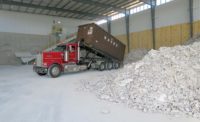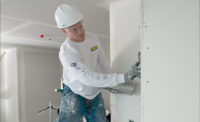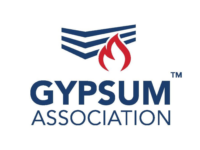The manufacturing industry is at an inflection point, and the supply chain field is changing right along with it. Historically, supply chains have been linear: sourcing raw materials, manufacturing the products, using the products and then disposing of them. This supply chain process is being phased out and a new circular economy model is taking its place. The circular economy model takes a holistic view of the supply chain industry. It eliminates waste and includes renewable energy wherever possible, creating more cost-effective products and making production more efficient.
At USG, the company aspires to develop innovative building solutions that enable customers to create sustainable, inspirational, inviting and safe spaces where we work, live and play. Every product family undergoes a lifecycle assessment to determine how much energy and water it uses, how it affects the air that we breathe and how much waste it creates.
The company’s Sheetrock Brand Gypsum Panels have been manufactured with recycled newsprint since the 1960s and use no paper bleach. This is one reason why the wallboards are not a bright white and instead are usually a dull shade of white.
In the traditional supply chain model, the company’s role in the lifecycle of a product would end after the distribution stage with little impact on the recycling process. But as a company that strives to be a constructive force for good in every community that we operate, the team felt that the manufacturer could play a bigger role in this new circular economy model.
The Potential to Do More
Wallboard waste has great potential for recycling, even though most of it ends up in a landfill. In May 2014, a cross-industry collaboration of stakeholders, who recognized that there was an opportunity for more to be done, got together and launched the Building Product Ecosystem. A collaborative effort with the Durst Organization, in partnership with the New School and the City University of New York, the BPE was launched with the goal of building a product ecosystem that was healthy for New York City construction. Through transparent material research and innovation, the BPE sought to focus on cradle-to-cradle recycling in a very challenging market.
Along with other gypsum wallboard manufacturers, USG was invited to participate in the process to develop a functioning model of wallboard recycling that would sustain itself into the future. Joined by building developers, research institutes, waste haulers, NGO’s, architectural consulting groups and end users, the group set out to understand the critical issues that would need to be addressed throughout the process in order to create a sustainable closed loop wallboard recycling model.
The Challenges
Closed-loop recycling of wallboard is rarely pursued due to the lack of incentives and mandates, and because the recyclability diminishes once moisture contamination, compaction and aggregation with other waste occurs. As such, during the installation of wallboard, there is significant waste created on the job site—wallboard cuts typically generate 10 to 12 percent of the waste in construction projects. Some of this waste will be reused for agriculture or site soil remediation purposes, and the vast majority of the waste ends up in landfills.
Historically, new construction wallboard waste is aggregated with other job site waste and taken to a landfill for disposal. The aggregation process crushes the gypsum into small pieces and fine gypsum dust that mixes with other materials. Once crushed, segregating this material from other construction materials is nearly impossible.
Even if all the clean scrap wallboard sent to a landfill was recycled, that would only offset 10 percent or so of the gypsum needed to make new wallboard. Therefore, diversion from landfill at the work site, before the wallboard is contaminated, is critical. Estimates of wallboard waste range from six to13 million tons per year, with just 300,000 tons of drywall recycled per year. Job sites in New York City are especially challenging, as they are very limited in space, and separating the wallboard from other waste is not something that is often done.
Another challenge was to ensure all stakeholders in the process were comfortable with the health and safety of the recycled gypsum. Representatives from CUNY conducted a detailed laboratory analysis of samples of the wallboard that was to be recycled to ensure that it met all of the quality specifications typically required by wallboard manufacturers. All of the quality requirements were met, and the stakeholders were comfortable moving forward with the recycling pilot.
The Process
Keeping wallboard scrap separated was a critical component of this project being successful. Waste from job sites is often commingled, and taken away in packer trucks. This results in contamination and mixed fines only really suitable for landfill, with some material salvaged for soil amendment. The better method is to keep wallboard scrap segregated and hauled away separately, drastically increasing the recyclability of the gypsum, and improving the recyclability of the other waste materials as well.
Building developer partners Durst and LendLease tackled the challenge of developing new ways to segregate the waste at the job site within the existing construction material waste handling process. During the wallboard installation phase, waste collected within that area is 95 percent clean wallboard scrap. The challenge lies in ensuring that the wallboard is kept separate from other waste at the job site and then taken off site in a dedicated container, and the process to recycle it into new wallboard is minimal. Once the dedicated mini containers are filled, they are taken immediately down to the loading dock to be deposited into larger containers where they are hauled away.
Cardella filled the waste aggregator role, collecting the wallboard from job sites and hauling materials to the recycling facility. USA Gypsum then managed the process of separating the paper or fiberglass facing from the wallboard and developing the wallboard gypsum into a powder that could be recycled. Given its proximity to New York City and USA Gypsum, USG’s Washingtonville, Pa. site was chosen as the site to recycle the material.
Sustaining the Model
BPE is an example of the circular economy in action, where collaborative work between stakeholders occurred during every step of the process and yielded significant results. The success of the pilot program was due in part to the region in which it took place. Transportation is the main driver of costs in recycling initiatives like this one, and in New York City the pilot benefitted from Cardella’s sorting facility location in New Jersey and USA Gypsum’s and USG’s locations nearby in Western Pennsylvania. Despite the logistical challenges, this effort can be expanded to other cities where significant quantities of wallboard can be recycled. The pilot program is still in progress and more wallboard manufacturers are encouraged to join the program.










Report Abusive Comment